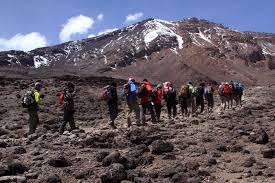Mount Kilimanjaro lies in the tropics and the seasons are marked more by variations
in rainfall then by changes in temperature. The main driving force controlling the climate
is the migration of the Intertropical Convergence Zone or ITCZ. The ITCZ marks the convergence
between the north and south trade winds and can be picked out in Satellite pictures as a broad
band of thunderstorms which encircles the globe.
What's the best time to climb Kilimanjaro
The best time to climb is from June to September (Long Dry Season) and from January to
February (Short Dry Season). June, January and February might be considered the best
months as they have great weather and not as many visitors come to the mountain.
The busiest time of year on the mountain is in September. On average the “Long Wet”
season lasts from the 25th of March until the 21st of May and we don’t recommend
climbing during this period although it is possible.
Is it possible to climb Kilimanjaro the rainy season?
One advantage to climbing during the wet seasons is that you will practically
have the mountain to yourself. Some climbers enjoy seeing the summit covered in
snow and the climbing experience is altogether different. However, trails are muddy and
the climbing more difficult due to the variable weather. You might be lucky but summit
conditions will likely be cloudy with little or no visibility. If you decide to give it
a go we suggest the
Marangu Route
so you can stay dry in the huts when you are done hiking for the day. Make sure to bring
good rain gear and waterproof covers for your pack.
The Seasons of Kilimanjaro
The Long Dry Season (June to September)
The long dry season is a great time of year to climb the mountain. Temperatures are
slightly colder then the short dry season but overall conditions are excellent with very
little chance of precipitation.
The Short Wet Season or Vuli (October to December)
The “Short Wet” season between October and December is associated the southward
migration of the Intertropical Convergence Zone. Rains during the short wet season are
much more unpredictable than those that occur during the “Long Wet”.
The Short Dry Season (January to February)
The “Short Dry” can be a good period for trekking especially during late January and
into February. Temperatures during this time period are generally warmer than during
the “Long Dry”. The “Short Dry” comes to end as the Intertropical Convergence Zone migrates
northwards and brings the “Long Wet” season.
The Long Wet Season or Masika (March to May)
On average the “Long Wet” commences about the 25th of March and ends on the 21st of May.
These dates are averages and quite a bit of year-to-year variability is observed so if you
want to avoid the rainy season give yourself a few weeks window on either side. The “Long Wet”
occurs as the Intertropical Convergence Zone migrates northwards over the region.
Given Kilimanjaro’s proximity to the equator one witnesses little variation
in monthly temperatures. The coldest periods is between May and August and the
warmest period is between November and February. Differences in temperatures
between the hottest and coldest months are about 10°C or 20°F.
The Kilimanjaro Micro-Climate
Kilimanjaro is a big mountain and creates its own weather and climate to a certain extent.
Even during the dry season it’s possible for rain to occur on the mountain as the moisture
laden air from the valleys raises and condenses around the summit. No matter what
season you go in its important to be properly prepared for rain.
 EN
EN CH
CH ES
ES DE
DE RU
RU
 FR
FR
 ET
ET
















